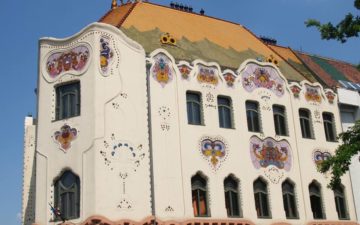The city council of Kecskemét decided to have the rental palace built in 1902 at the corner of the new and modern „Avenue” (soon after Rákóczi) Road. A young architect, Géza Márkus was commissioned to design the palace. The external appearance of the building is dominated by the colourful majolica ornaments. Between the rows of the green windows of the first and the second floor the elements of the international Secession and the ornamental motives of Hungarian folk art are combined. The decorative ceramics (majolica, pyrogranite, and eosin) were executed by the Zsolnay Porcelain Manufacture of Pécs.
The building was designed multifunctional, most probably, because of economic reasons. Shops to rent lined the ground floor (e.g. picture, mirror, lamp, shoes). Today, there are windows in the space originally occupied by the former shop-fronts and shop windows. The grand hall and the association rooms of the Casino of Commerce were located on the first floor, while three apartments were housed on the second floor. Two staircases were built accordingly, the more decorated to the Peacock Hall, whereas the other to the former apartments.
The Peacock Hall was named after the peacocks made of painted plaster stucco. It used to be a ballroom. There might have been two huge mirrors in the space between the windows, and traces of ornamental wall painting were found in the heart shaped space. The real beauty of the hall is the two brass chandeliers with Tiffany glass inlays.
Since 1983 the building has been functioning as a museum. Since 1996 it houses the permanent and seasonal exhibitions of the Katona József Museum of Kecskemét.







